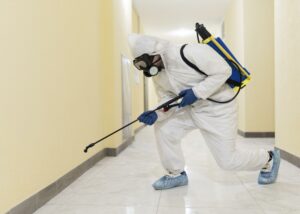 Pests are nature’s escape artists, often smarter than most people realize. They’re not just a nuisance; they’re relentless and adaptive to climate changes, existing control methods and urban development.
Pests are nature’s escape artists, often smarter than most people realize. They’re not just a nuisance; they’re relentless and adaptive to climate changes, existing control methods and urban development.
Fortunately, new technology in pest control allows for early detection and timely intervention. This guide delves into the latest tools and techniques that make pest control safer and more effective than ever.
1. Insect and Rodent Birth Control
Sterilizing insects typically involves irradiation during their larval stage, after which they are released. Once they mature into flies and mosquitoes, they lose their ability to reproduce. This method reduces pest numbers while allowing them to remain in the ecosystem as beneficial organisms.
While effective in agricultural and ecological settings, sterilization might not be suitable for individual households since it demands specialized equipment, strict monitoring and a controlled environment.
Birth control for rat and mouse populations is administered orally through baits. Companies are now testing oral contraceptives designed to prevent rodents from reproducing for up to 45 days per dose.
One such EPA-registered oral contraceptive operates using two active compounds: one induces a form of menopause in females, and the other, known as triptolide, restricts sperm production in males. When administered cumulatively over time, this product is reported to decrease populations by 95%.
2. Canine Inspections
Scientists claim that a dog’s sense of smell is 10,000 to 100,000 times more powerful than that of humans. What’s even more remarkable is they can use each nostril independently, allowing them to detect multiple scents in different parts of a room simultaneously.
Canine inspections are a growing trend in modern pest management. They’re non-intrusive and minimize the use of chemicals. Trained canines, guided by their handlers, excel in detecting bed bugs, termites and their eggs. They can cover large areas quickly, leading to faster detection and treatment of pest problems. Dogs can also find pests in their early stages, preventing minor issues from escalating.
3. The Internet of Things
The Internet of Things (IoT) is transforming various industries, including pest control. IoT refers to the network of interconnected devices and systems that communicate and exchange data over the internet. Everyday devices like smart home security systems, appliances and wearable devices can be integrated into the IoT ecosystem.
In pest control, IoT technology helps efficiency, accuracy and sustainability. IoT-enabled sensors and cameras can be placed in strategic locations to monitor pest activities in real time. Property owners can then take proactive measures based on this data.
These pest innovations are also seamlessly integrated with pheromone dispensers. Using the received data, dispensers promptly release chemical substances that influence pest behaviors, minimizing response time and the impact of infestations.
Additionally, IoT technology enables hyper-local weather tracking. Monitoring factors like humidity, temperature, and moisture aids in predicting the scale and threat posed by pest populations. This data-driven approach allows property owners to take prompt action and prevent infestations before they occur.
4. Heat-Detecting Drones
Managing pests on vast expanses of land like farmlands and large estates proves both time-consuming and costly. Manual detection methods, like searching for scats, footprints or trails, are time-consuming and unreliable.
Drones with thermal imaging technology efficiently identify pests, nests, and movement patterns. They can swiftly detect many nocturnal species, such as possums and rats.
Living organisms, including pests, produce heat due to metabolic processes. Heat-detecting drones can identify temperature variations, making it possible to spot pests in a cooler background environment. This variation in heat signatures enables the drone to detect their presence even in dark or dense vegetation.
5. Modern Mosquito Baits
Traditional mosquito baits, once a common solution for residential pest problems, are becoming less effective. In addition, they tend to lure even beneficial insects, such as ladybugs and spiders.
A study found that disease-spreading mosquitoes learn to recognize the scent of pesticides after a single sub-lethal exposure, prompting them to avoid contact in the future.
New technology in pest control allows for precise targeting of disease-carrying mosquitoes. Smarter mosquito attractants boost the catch rates of mosquito traps by using a lactic acid-based formula that imitates human skin scent. This reduces the risk of dangerous infections like dengue, Zika or chikungunya.
6. Aesthetic Fly Lights
Fly lights are a well-known tool in pest management. These electronic traps utilize Ultraviolet (UV) light to lure insects towards an attached glue trap. However, they can be an eyesore, often clashing with interior aesthetics.
Thanks to new technologies, fly lights can seamlessly integrate into your living spaces and are more versatile than ever.
Modern fly lights boast sleek designs and adaptable features, offering discreet yet powerful pest control. These pest innovations are user-friendly and practical, perfect for bars, hotels, cafes and restaurants. Some models are crafted to lure flying insects from a complete 360° radius around the unit.
Protect Your Property: Choose Pest Control Unlimited Today
Stay one step ahead of costly infestations with cutting-edge pest innovations. At Pest Control Unlimited, we leverage new technology in pest control to protect your space all year round. Our services include bed bug spray, mice extermination, tick spray and more.
Before introducing any new products to your property, we rigorously test them in our own homes and facilities. We stay ahead of the latest pest innovations by attending training seminars, recertification classes and trade shows.
Our reputable team proudly serves Middlesex County in Massachusetts and the surrounding areas. Choose from one-time and quarterly program visits suitable for both residential and commercial properties. Get in touch now for a free quote.

